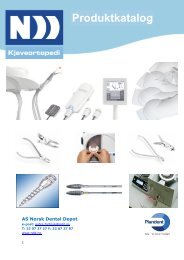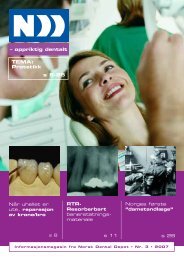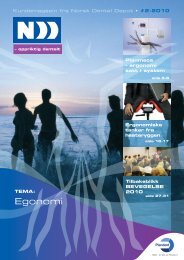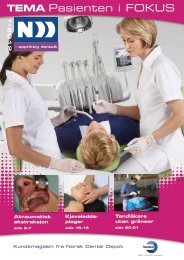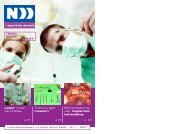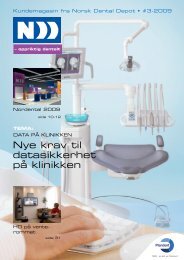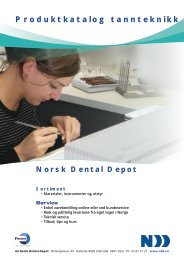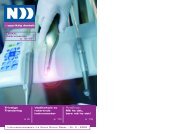Biodentine
Biodentine
Biodentine
Create successful ePaper yourself
Turn your PDF publications into a flip-book with our unique Google optimized e-Paper software.
22<br />
4.3 - Genotoxicity tests (ISO 7405, ISO 10993-3, OCDE 471)<br />
Several genotoxicity tests were performed on the <strong>Biodentine</strong> cement. They were<br />
carried out on extracts of the cement after complete setting.<br />
AMES test performed on Salmonella typhimurium and Escherichia coli. Strains TA98,<br />
TA100, TA1537, TA1535, pKM101 in absence or presence of metabolism activator.<br />
Results showed that <strong>Biodentine</strong> was not mutagenic (Harmand, 2003).<br />
Another AMES test was performed on 4 strains of Salmonella typhimurium TA97A, TA98,<br />
TA100 and TA102. The results showed that cement <strong>Biodentine</strong> does not induce reverse<br />
mutation in the presence or absence of the metabolic activator S9. Identical results were<br />
reported for the four strains of bacteria tested (Laurent et al., 2008).<br />
An in vitro micronucleus test was also carried out using human lymphocytes (Laurent et<br />
al., 2008). These were exposed to extracts of <strong>Biodentine</strong> obtained either from a culture<br />
medium or DMSO. Dilutions of 1% to 5% of the extracts were used. After a culture time<br />
of 72 hours, the cells were stained and analysed. 1000 bi-nucleated lymphocytes were<br />
tested, to check for a micronucleus. A toxicity index was determined, together with a<br />
ratio for the number of micronuclei in relation to the negative reference. The results<br />
showed that after incubation of the lymphocytes with different dilutions of the extract of<br />
<strong>Biodentine</strong>, the number of lymphocytes presenting a micronucleus was similar to that<br />
obtained with the negative reference (3.9% to 4.1%) when concentrations of 1% to 5%<br />
in an aqueous or hydrophobic medium were tested. Positive controls produced a<br />
micronucleus rate of 16% (Fig. 2)<br />
<strong>Biodentine</strong> Micronucleoted<br />
lymphocytes (%±SD)<br />
1% 4.0±1.1<br />
2.3% 4.0±1.1<br />
3.7% 4.0±1.2<br />
5% 4.2±1.2<br />
- control 3.7±1.2<br />
+ control 16.0±6.0*<br />
Table 3. Micronucleated lymphocytes<br />
after contact with <strong>Biodentine</strong> .<br />
<strong>Biodentine</strong> Tail DNA mean<br />
dilution (%±SD)<br />
0.1% 12.59±0.96<br />
1% 13.31±0.88<br />
10% 14.90±1.06<br />
Undiluted 15.58±1.08<br />
Negative control 13.19±0.96<br />
Positive control 46.52±1.45*<br />
Table 4. Tail DNA mean after contact<br />
with <strong>Biodentine</strong>.<br />
Finally, the comet test on human pulp<br />
fibroblasts was conducted (About, 2003a).<br />
The extract of <strong>Biodentine</strong> was prepared in<br />
DMSO and a culture medium, at 50 mg/ml for<br />
24 hours and at 37°C. The cells were exposed<br />
directly to increasing dilutions of cement<br />
extracts for two hours. Following electrophoresis,<br />
the slides were analysed by<br />
fluorescent microscopy (magnification 400)<br />
and an automated analyser was used to<br />
determine DNA lesions. The results obtained<br />
showed that the percentage of tail DNA varied<br />
from 12.59 for a dilution of 0.1% to 15.58 for<br />
the undiluted medium. It was 13.19 for the<br />
negative control and 46.52 for the positive<br />
control (Table 3). In the presence of DMSO,<br />
there was no significant difference between<br />
the genotoxicity of <strong>Biodentine</strong> and the<br />
negative control (extracted with NaCl and<br />
DMSO).



